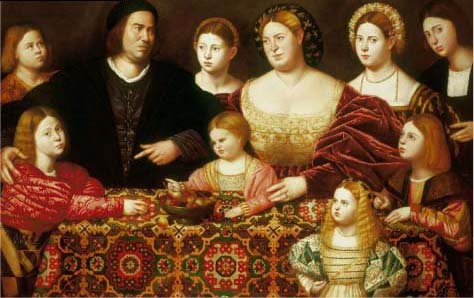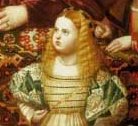
Bernardino Licinio was born in Venice around 1489 during the Italian High Renaissance. It is thought that he could have trained as an artist in the workshop of Giovanni Bellini, the founder of the Venetian School of Painting. Although being influenced by his “master”, Licinio soon developed his own down-to-earth style of realism painting. When he had finished his artistic apprenticeship, Licinio set up his own workshop and produced a number of half length panels of the Virgin and Child, some altarpieces and group portraits one of which is featured in My Daily Art Display for today. It is simply entitled A Family Group and was painted by Licinio in 1524.
In the painting we see nine members of a family. It was once thought that it was an actual portrait of Licinio’s own family but there has been no documented evidence that he was ever married. Licinio was famous for his group portraits and a few years after today’s painting he completed two similar works, namely, Arrigo Licinio and his Family (1535) and Portrait of a Sculptor with Five Apprentices(c. 1530) and all three are looked upon as his greatest works.

The members of the family are grouped around a table on which we see a Turkish table carpet, known as a small-patterned Holbein named after its characteristic geometric design. These carpets are of Ottoman origin and so named because Hans Holbein used to often incorporate them into his paintings. The “small pattern” terminology referred to the small size of the motifs. These were expensive carpets and in paintings often symbolised wealth and in this case we are being subtly told that this family did not have any financial problems.
What I like about this family portrait is its realistic quality. How many times have you wanted a family photograph taken with your children only to be thwarted by arguments between the young ones? This is exactly what Licinio is recording in the painting. The young boy in the elaborately painted striped hose, seated at the end of the table on the left, has just taken an apple from the bowl and of course this was the very one which his siblings had wanted. Sounds familiar? We can see the father, dressed in black, attempting to mediate in the argument. His wife, in the gold and cream low-cut dress, is listening intently to his proposed solution.

My favourite character in the painting has to be the young girl standing in front of the table in the right foreground. Look how she stands defiantly, arms akimbo, lips pouted as she demands justice. Although she maybe the youngest of the siblings she demands to be heard. The one aspect of the painting which art critics have commented on is that there seems to be no face-to-face interaction between family members. They fail to relate to each other.

Compare this with, for example, Lotto’s 1547 family painting, Portrait of Giovanni della Volta with his Wife and Children, which has a similar bowl of fruit on a carpeted table but where there is an interaction between the family members or Giovanni Cariani’s Seven Members of the Albani Family (above) where everybody seems so animated. Licinio’s family group seem to be just a collection of individuals who have no connection with each other. The difference in style of the two portraits reminds me of two photographs a family photographer has taken. In one he has instructed everybody to be still and look at the camera. The result is a wooden photo, which often occurs in a formalised event where everybody has to stand still and look at the camera and not at each other. In the other the photographer has let things develop naturally before he presses the camera button without warning.
